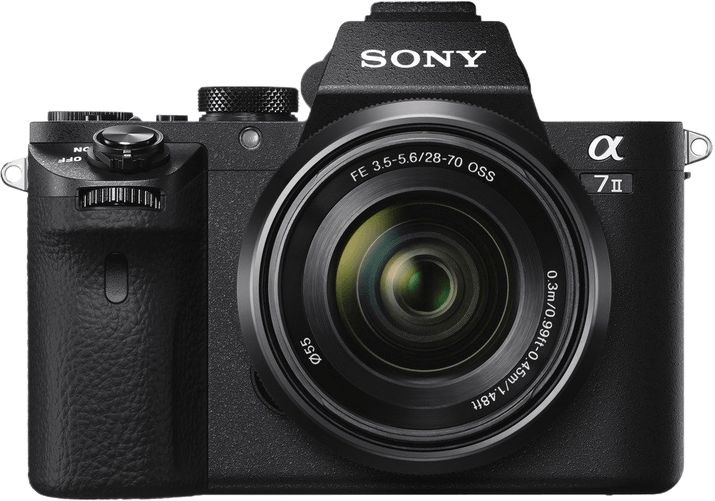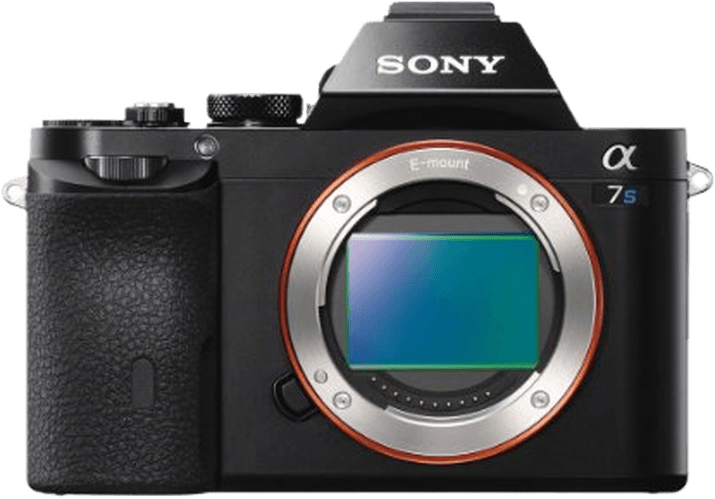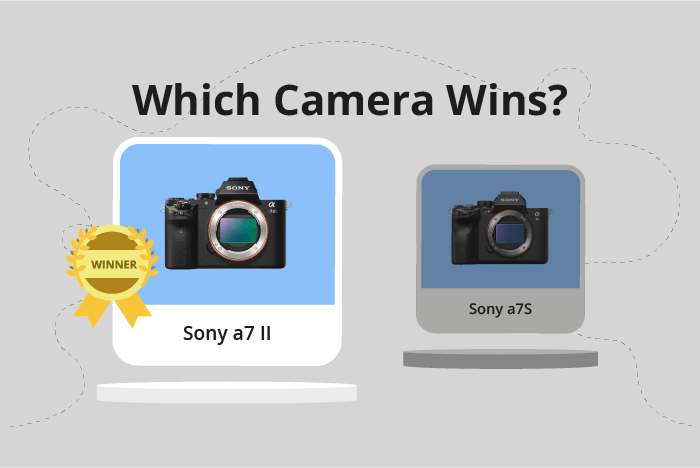Sony a7 II vs a7S Comparison
Sony a7 II

Sony a7S

The Sony a7 II outperforms the Sony a7S with a score of 69/100 compared to 55/100. Both cameras are mirrorless and were released in 2014. They share the same dimensions, with the a7 II being slightly heavier at 599g compared to the a7S at 489g.
The Sony a7 II’s higher score signifies its superior performance. It offers better value with a launch price of $1600, while the a7S originally cost $2499. However, the Sony a7S does have an advantage in being lighter, making it more portable for photographers on the go.
Taking these factors into account, the Sony a7 II is the stronger choice for most users due to its better performance and affordable price. The Sony a7S may be a better option for those who prioritize portability above all else.
Sony a7 II vs a7S Overview and Optics
The Sony a7 II triumphs over the Sony a7S in the optics department with a score of 78/100 compared to the latter’s 60/100. Both cameras share several specifications, such as a CMOS sensor, Bionz X processor, shooting speed of 5fps, full-frame sensor size, and the same lens mount. Despite these similarities, the Sony a7 II outperforms the a7S in certain aspects.
One of the main advantages of the Sony a7 II is its higher megapixel count of 24.2, compared to the a7S’s 12.2. This results in better image resolution and detail, allowing for larger prints and more cropping flexibility. Additionally, the a7 II boasts a higher DXOMARK sensor score of 90, which implies superior overall image quality and better low-light performance than the a7S with its score of 87.
Another significant difference is the presence of image stabilization in the Sony a7 II. This feature helps reduce the impact of camera shake, enabling sharper images even at slower shutter speeds. The Sony a7S, on the other hand, lacks this function, making it more prone to blurry images due to camera shake.
However, the Sony a7S does have its merits. Its lower megapixel count allows for better high ISO performance and less noise in low-light situations, making it a suitable choice for videographers or those who frequently shoot in dimly lit environments.
Taking these factors into account, the Sony a7 II emerges as the superior choice in terms of optics, offering a higher megapixel count, better overall image quality, and image stabilization. The Sony a7S, while not as versatile, still provides excellent low-light performance, making it a viable option for specific shooting conditions.
Sony a7 II vs a7S Video Performance
The Sony a7 II and the Sony a7S both have a video score of 56/100, indicating that their video capabilities are quite similar. Both cameras share common specifications, such as Full HD maximum video resolution, 1920 x 1080 maximum video dimensions, and a maximum video frame rate of 60fps. Additionally, neither camera has built-in time-lapse functionality.
Despite having the same video score, the Sony a7 II offers some advantages over the a7S. The a7 II’s in-body image stabilization helps to reduce camera shake, resulting in smoother and more stable videos. This feature is particularly useful when shooting handheld or in low light situations.
On the other hand, the Sony a7S has its own strengths, such as its exceptional low light performance. The a7S is known for its ability to capture clean, noise-free footage in dimly lit environments, making it an ideal choice for videographers who frequently shoot in challenging lighting conditions.
Taking these factors into consideration, it is clear that both cameras have their own unique strengths and weaknesses when it comes to video capabilities. The Sony a7 II’s in-body image stabilization may be more appealing to those who prioritize smooth and stable footage, while the a7S’s low light performance will be more attractive to videographers who often shoot in poorly lit environments. Ultimately, the choice between these two cameras will depend on the specific needs and preferences of the user.
Sony a7 II vs a7S Features and Benefits
The Sony a7 II wins in the feature comparison with a score of 57/100, while the Sony a7S scores slightly lower at 54/100. Both cameras share several specifications, making them comparable in many aspects. They both have a 3-inch screen size, lack a touchscreen, feature a flip screen, do not have GPS, and include WIFI connectivity. Additionally, neither camera offers Bluetooth capability.
The Sony a7 II outperforms the a7S in screen resolution, boasting 1,230,000 dots compared to the a7S’s 921,000 dots. This higher resolution provides a clearer and more detailed image when reviewing photos on the camera’s screen. This advantage enhances the user experience, making it easier to review and adjust settings during shooting sessions.
The Sony a7S, despite its lower feature score, has its own strengths. Although it has a lower screen resolution, the camera still offers a flip screen and WIFI connectivity, making it suitable for photographers who prioritize these features. However, it is important to note that the a7S does not surpass the a7 II in any specific feature.
Based on the feature comparison, the Sony a7 II is the stronger camera due to its higher screen resolution. The Sony a7S may still be a suitable option for some photographers, but it does not offer any distinct advantages over the a7 II. Therefore, the a7 II is the recommended choice for photographers seeking a camera with better features.
Sony a7 II vs a7S Storage and Battery
The Sony a7 II and Sony a7S show similar performance in this area. Both cameras have one memory card slot and accept SD/SDHC/SDXC, Memory Stick Duo/Pro Duo/Pro-HG Duo cards. They also utilize the same NP-FW50 battery type. The a7 II has USB charging capabilities.
However, the Sony a7S has a slight advantage with a battery life of 380 shots, compared to the Sony a7 II’s 350 shots. This difference may not be significant for casual users, but it could be crucial for photographers who require longer shooting sessions without changing batteries.
The Sony a7 II does not have any advantages over the Sony a7S in terms of storage and battery. Both cameras share the same specifications, with the exception of the a7S’s marginally better battery life. This similarity in performance indicates that storage and battery should not be the deciding factors when choosing between these two cameras. Instead, potential buyers should consider other features and specifications to determine the best fit for their needs.
Sony a7 II vs a7S – Our Verdict
Are you still undecided about which camera is right for you? Have a look at these popular comparisons that feature the Sony a7 II or the Sony a7S:

